#sol Invictus deity
Explore tagged Tumblr posts
Text
Why Saturnalia/Sol Invictus/Yule, are 100% better; than Christmas!
Since I was a kid, I was part of the celebrations for Christmas (since helping to put the dishes, till wearing new clothes to show to your friends; and/or visiting relatives); but... Sadly, the joy I felt at Christmas's Eve; and during all the season, disappear way before my first decade of life: I really didn't want to celebrate Christmas, anymore! But people never asked me, why I don't like to celebrates "The Most Wonderful Time of The Year!" Well, I'm going to resume it, in three things:
People, behave at its worst in this date...: Fighting in the table, drinking too much and behave badly after; eating till getting sick, and... You name it! (Unbelievable that, in a time for "Peace, Love and Celebrating The Birth of someone of high morale..." People acted, in such poor behavior...)
All revolves around Materialism (...And Selfishness): More than a decade ago in my country, it started the costume than you must give gifts in Christmas; and since then... If you can't find or have money to get the present, you are look badly by the person/s than didn't receive his/her/their gifts; which decides to doesn't speak to you again, till the next Christmas! Also, some people only desires to be the ones than receives attention/help/gifts/ in this time; BUT... Doesn't feel they need to give or return nothing to the people/community, or even; to their friends and/or family. (A time than must be to try to be a better person, than many picks to only thinks in their own needs) And, at last;
The Christmas's Hipocrisy: People/Neighbors wishing you "Happiness and Love in the next year!", but... Never back to speak to you, or remember than you exist, in the next 364/365 days of the year! (Which... Is a very rude and cruel thing, to make)
Now... Since I found out about "The Winter's Pagan Holidays"... I feel like that joy, that I lose in my Childhood; Has returned again into my life!
Why Saturnalia, Sol Invictus and/or Yule; are way better than it's more popular counterpart?! They are for this reasons:
Remarks about acting well and unity in the Family/Community: Since inmemorial times, are stories (real and legendaries) about how people behave with more love and goodness; to their family/friends/the community. So, our ancestors marked the way to behave in this time: Helps to your Community, and... Eat your fest in this time, treating to the ones at your table; with the upmost respect!
Gifts... Are not the most important thing in this time: The most important thing in this time of Saturnalia/Sol Invictus/Yule... Is having a feast with your family, with friends you love as family; or, even sharing a plate of dinner with someone than you know than doesn't have to eat; or to invite to someone you know than will be alone in this time. (Plus: If someone gifts you sometime or not, it doesn't changes your mood; 'cause you feel happy to even being able to celebrate this holiday/s, a year more! ... And the gifts than are handmade, are more than welcome: It means than someone invest their time and efforts, thinking in gives you something made with love, than makes you happy!)
Is a time to do something good for others, and being less selfish: You can take a time to volunteer in the cause of your liking, cleaning repairing old toys and gifts them to poor kids; helping a person to learn to read and write, and... Even giving a helpful advice, or sitting and hearing to someone for five minutes than is in bad moment; are things you came make to brighten someone's day! And, at last;
Reparts Joyness to all around you, in this time... And, beyond!: Says than you wishes than anyone than you greet, than they have a great time and year; from your heart, and... Don't let to your neighbors and friends abandoned, for the rest of the year: Show them than they really are important to you, and than your Winter's Greetings, "Wasn't only to being polite..."
That's all in this post, and remember; to do good and being happy, in this magical time: Happy Sol Invictus, AND... So Be It!
#paganism#pagan writer#pagan advice#pagan holidays#happy sol Invictus#sol Invictus deity#to all the pagans#to all the wiccans#to all the witches#pagans#pagan#eclectic pagan#ecletic pagan#hellenic pagan#pagan from the caribbean#than the sol Invictus and the deities helps you to persevere and conquer any obstacles in your life and shine the best of you like the sun#so be it
3 notes
·
View notes
Text
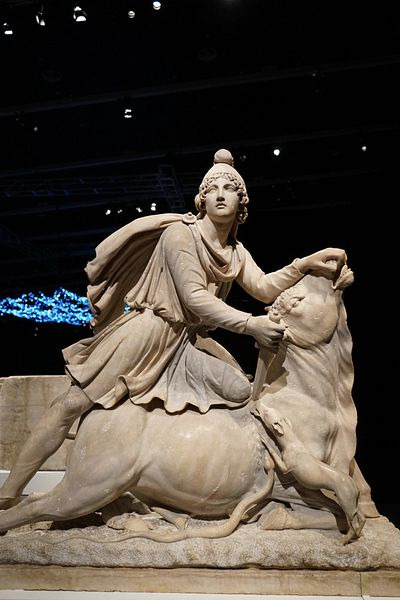

Mithras slaying the bull, Tauroctony. Roman, British Museum.
#mithras#mithraism#sol invictus#roman polytheism#Mithra#iranian polytheism#zoroastrianism#statue#art#artwork#god of the sun#sun god#mithraic mysteries#Tauroctony#mithras deity#mithra deity#deus#mithras deus#roman mythology#roman gods#hindu mythology#hindu polytheism#iranian mythology#classical art#artists on tumblr#Roman
45 notes
·
View notes
Text
PSA to my brethren

Because St. Valentine's day has ONCE AGAIN given fake news regarding Christian holidays AMPLE opportunity to spread like wildfire, I am obligated to point out the following, for the umpteenth time:
No, Christmas is NOT Saturnalia or Sol Invictus. Jeremiah 10, by the way, is NOT a text about Christmas trees.
No, Easter does NOT come from feasts of Ishtar. It is literally called an equivalent of "Passover" in practically all non-English Western languages.
No, Halloween is NOT Samhain. The two do not even fall close on the calendar.
No, St. Valentine's day is NOT Lupercalia. There is no link between the two, any more than the Greco-Italian war is related to the fiscal policies of the Song Dynasty.
No, Sunday worship is NOT a hidden celebration of Sol. We celebrate Communion on Sunday because our Lord rose from the dead on a Sunday, not because we have "changed the day of the Sabbath"; we have not, and I also assure you that Constantine had NOTHING to do with this.
I cannot believe that we have reached the point where I really have to emphasise this: St. Patrick has nothing to do with Pan, much less with Peter Pan.
If you are interested in learning about the origins and evolution of Christian feasts, consult the work of actual scholars like Ronald Hutton. Jack Chick, John Ramirez, The History Channel, and ChatGPT are NOT reliable sources, for crying out loud.
Quoting Isaiah 5:20 and James 4:4 whilst presupposing that your argument about holidays is true...does not prove that your argument about holidays is true.
Most importantly: especially if you are a follower and worshipper of Jesus Christ, washed in the blood of the Lamb and partaker of the holy Sacrament of the altar, then you cannot "accidentally" worship pagan deities which nobody has worshipped for millennia simply by virtue of decorating a tree, or making a log-shaped pudding, or hunting for chocolate eggs, or going to a ball dressed up as Legolas or Esmeralda, or giving your wife red roses.
Please let us calm down at last. The Holy Spirit does not go on annual leave on 2/14, 10/31, 12/25 or ANY other day of the year. Stop propagating lies and half-truths peddled by attention-seeking "armchair pastors" -- this cultivates an increasingly strong mentality of "touch not, taste not, handle not" which borders on adding to the Gospel.
Stop giving the devil right to call dibs over innocuous practices; rather reclaim the good things of life in the power of Christ.
176 notes
·
View notes
Text
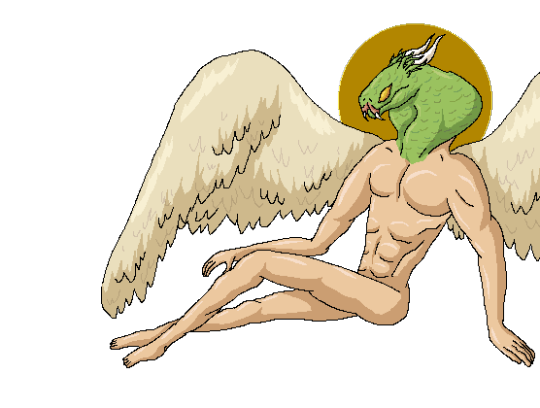
Don't worry about Lucifer btw. He's chill.
Starting my motw campaign: "Hey, it might be cool to add political intrigue to the magical underworld."
Now, over a year in: "These are the factions that control the former united states."
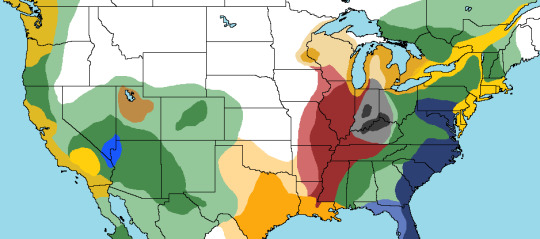
#sol invictus#zeus greek mythology#zeus deity#zeus#horus#ra#egyptian mythology#egypt#fantasy#worldbuilding#urban fantasy#inanna#mages#wizard#my worldbuilding#dragons#motw campaign#motw rpg#dragon#motw#monster of the week#ttrpg campaign#fantasy map#lucifer#satan#demon boy
327 notes
·
View notes
Text
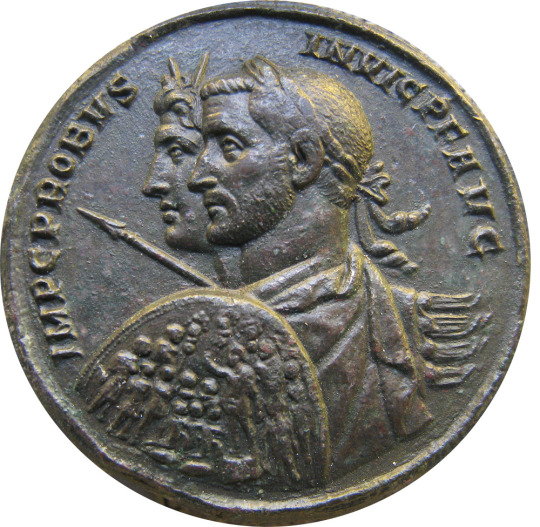
Coin minted ca. 280 CE by the Roman emperor Marcus Aurelius Probus (r. 276-282). Probus is shown in the company of Sol Invictus ("Unconquered Sun"), a late form of the solar deity whose worship had been promoted by Probus' predecessor Aurelian. The birthday of Sol Invictus (Dies Natalis Solis Invicti) was traditionally celebrated on Dec. 25. On this coin, Probus, who was constantly on campaign during his brief reign, is shown prepared for battle with shield and spear, alongside Sol Invictus, who wears his characteristic radiant crown. Now in the National Museum of Denmark, Copenhagen. Photo credit: ChrisO/Wikimedia Commons.
#classics#tagamemnon#Ancient Rome#Roman Empire#ancient history#Roman history#Probus#M. Aurelius Probus#Roman religion#Ancient Roman religion#religio Romana#Sol Invictus#art#art history#ancient art#Roman art#Ancient Roman art#Roman Imperial art#coins#ancient coins#Roman coins#Ancient Roman coins#numismatics#ancient numismatics#Roman numismatics#National Museum of Denmark
458 notes
·
View notes
Text
Summer Solstice
༺═─────═༻ ☀️ ༺═─────═༻
About: The Summer Solstice, also called Lithia, or Midsummer
Length: 1-3 days of celebration starting the day before the solstice or starting the day of the solstice and continuing a few days after
Celebrates: the first day of summer and changing of seasons, the longest day of the year, and the peak of the sun's power
Date: June 20th, 2025, falls on June 20-21 varying each year
༺═─────═༻ ☀️ ༺═─────═༻
🧡 Color Associations: White, Yellow/Gold, Green, Red, Orange
💛 Color Meanings:
White - peace, cleansing, healing
Yellow/Gold - prosperity, success, harvest
Green - nature, growth, abundance
Red - passion, courage, transformation
Orange - enthusiasm, creativity, joy
🌙 Deity Associations:
Greek - Apollo, Helios, Persephone, Hestia
Roman - Sol Invictus, Vesta, Aestas
Celtic - Lugh, Aine, Brigid, Sulis
Norse/Germanic - Sunna/Sol
🔮 Crystal Associations:
Carnelian
Sunstone
Citrine
Tigers Eye
Quartz
Amethyst
🌿 Herb Associations:
St. John's Wort
Chamomile
Lavender
Mugwort
Rosemary
Thyme
Sage
Mint
Rose
🌸 Flower Associations:
Sunflowers
Lavender
Rose
Peonies
Daisies
༺═─────═༻ ☀️ ༺═─────═༻
🔥 Ways to Celebrate:
Bonfire
Gatherings
Simple rituals
Carry associated crystals and charge them in the sun
Make a spell jar of summer herbs
Readings and divination
Burn summer candle or candle with color associations
Wear colors with color associations
Make/eat summer foods like Honeycake, fruits, etc
#witchcraft#witchblr#summer solstice#solstice magic#green witch#spellwork#divination#paganism#pagan witch#hellenic pagan#pagan#midsummer#spells#rituals#crystals
27 notes
·
View notes
Text
YULE





DATE: December 21st-January 1st
ZODIAC: Capricorn and Aquarius
SYMBOLS: Yule log, evergreen trees, holly, mistletoe, candles, sun wheel, bells, wreaths, lights, ornaments, snowflakes, and gifts.
INCENSE AND OILS: cedar, pine, myrrh, frankincense, cinnamon, orange, juniper, and orange.
SPELLWORK: renewal, rebirth, gratitude, abundance, inner peace and joy, spiritual growth, enlightenment, and healing.
ANIMALS: deer, robins, bears, owls, squirrels, wren, goats, wolves, foxes, and cardinals.
COLOURS: gold, white, red, green, silver, and blue.
FOOD: roasted meats, grains, dried fruits and nuts, root vegetables, baked goods, cider, pudding, fruit cakes, and mice meat.
DEITIES: Sol Invictus, Loki, Mithras, Apollo, Freyja, Baldur, Dionysus, Hestia, Lilith, and Odin.
HERBS AND FLOWERS: evergreen, mistletoe, peppermint, yarrow, holly, bay leaf, cinnamon, orange peel, rosemary, yarrow, poinsettias, ivy, and winter jasmine.
CRYSTALS AND STONES: red jasper, clear quartz, garnet, citrine, bloodstone, labradorite, moonstone, snowflake obsidian, diamond, and ruby.
YULE SIMMER POT: rosemary, cinnamon sticks, orange slices, cranberries, and bay leaves with or without New Year intentions written on them.
#fyp#fypシ#fypシ゚viral#fypage#fyppage#tumblr fyp#witchcraft#witches#witch#witchcore#witch community#witchy things#sabbats#yule#wheel of the year#information#helpful
73 notes
·
View notes
Note
I've been seeing some essays from some authors whose tried to refute the syncretism of Apollo with Helios/Sol and Artemis/Diana with Selene/Luna, one of those even called syncretism a "decadent" practice… I mean, i know that them as sun and moon deities wasn't their primal role and wasn't very common or popular in religion nor mythology being Roman or Greek (in fact, in mostly of textes and cults Helios/Sol and Selene/Luna were always viewed as th Sun and the Moon), but i think that said that Apollo an Artemis/Diana were never viewed as sun and moon deities or claimed that was just a misconception and a modern misinformation is not true, because we have textes in which we could see associations of the Sun and the Moon with Apollo and Artemis/Diana.
Personally i like to see them more in a "sunlight and moonlight", and well of course focus in other of their more main and primarly roles, not as the sun and the moon, those are Helios and Selene. But i don't like when people bothers others who sees twins as sun and moon deities arguing that is wrong, or a misconception. I could quote some ancient authors whose associated them with solar and lunar aspects, but, as those essays claims, they would said that are misinformation or a "not-reliable" text source 😮💨
yeah, it's very true that though they were not THE sun and moon gods, they were still heavily associated with it!
even in Greece, in Artemis's case at least, she was worshipped in a triple cult alongside Selene and Hecate. As for Apollo, while "light" can refer to multiple things, such as in relation to prophecy, I genuinely think it also refers to his connection to the sunlight.
he has been describe as. you know. glowing before. and not for any particular purpose either. not much of a stretch for that to apply to being the literal god of light.
and I totally agree with you anon! i see them as the light of the sun and moon too!
i think there's may be a bit too much emphasis on "getting the myths right!" when it comes to the differences between Greece and Rome - I'm on board with people finally understanding what relates to which, but there must also be an understanding that lots of times, they intersected. Apollo and Diana likely became popularized as the sun and moon because they were just more relevant to the Romans' lives, with Apollo even becoming an important figurehead in the cult of Sol Invictus - even then, he was worshipped WITH Helios and Sol.
There is never just one specific god for one specific thing, and to minimize each gods' importance based solely on "oh that's ANOTHER god" downplays their individuality.
Like for example, I could just say "APOLLO is the god of the arts, NOT the Muses!!" and I would technically be correct, but also be missing MASSIVE CONTEXT because Apollo is the patron and god of the arts, but the Muses are the patrons and goddess of SPECIFIC arts.
"EILEITHYIA is the goddess of childbirth, NOT Artemis!" also technically correct, BUT Artemis is the patron of childbirth and midwifery BECAUSE of her function as a protector of the young, and also because of the rough birthing her own mother went through where in one version, she helped deliver Apollo - another connection to her patronage of childbirth.
Hyperion, Helios, and Apollo all serve different functions of the sun (such as its physical manifestation, path, and light), just as Selene, Hecate, and Artemis serve different functions of the moon (such as the different phases)!
if anyone has anything to add on about Apollo and Artemis and their connections to the sun and moon, and especially in relation with the other gods, feel free to add on!!
#the oracle speaks#asked and answered#anonymous#greek mythology#apollo#artemis#helios#selene#hecate#hyperion#greek myths#ancient greece
24 notes
·
View notes
Text
THIS DAY IN GAY HISTORY
based on: The White Crane Institute's 'Gay Wisdom', Gay Birthdays, Gay For Today, Famous GLBT, glbt-Gay Encylopedia, Today in Gay History, Wikipedia, and more … December 25





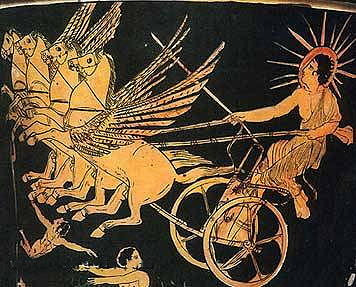
Sol Invictus ("the Unconquered Sun") or, more fully, Deus Sol Invictus ("the Unconquered Sun God") was the late Roman state sun god. The cult was created by the emperor Aurelian in 274 and continued until the abolition of paganism under Theodosius I. The Romans held a festival on December 25 called Dies Natalis Solis Invicti, "the birthday of the unconquered sun."
The use of the title Sol Invictus allowed several solar deities to be worshipped collectively, including Elah-Gabal, a Syrian sun god; Sol, the patron god of Emperor Aurelian (270-274); and Mithras. Oh, and a Jewish upstart named Jesus.
December 25th was also considered to be the date of the winter solstice, which the Romans called bruma. It was therefore the day the Sun proved itself to be "unconquered" despite the shortening of daylight hours. (When Julius Caesar introduced the Julian Calendar in 45 B.C.E., December 25th was approximately the date of the solstice. In modern times, the solstice falls on December 21st or 22nd.)
The Sol Invictus festival has a "strong claim on the responsibility" for the date of Christmas, according to the Catholic Encyclopedia. Solar symbolism was popular with early Christian writers as Jesus was considered to be the "sun of righteousness."
The date for Christmas may also bear a relation to the sun worship. According to the scholiast on the Syriac bishop Jacob Bar-Salibi, writing in the twelfth century:
"It was a custom of the Pagans to celebrate on the same 25 December the birthday of the Sun, at which they kindled lights in token of festivity. In these solemnities and revelries the Christians also took part. Accordingly when the doctors of the Church perceived that the Christians had a leaning to this festival, they took counsel and resolved that the true Nativity should be solemnized on that day." (cited in "Christianity and Paganism in the Fourth to Eighth Centuries", Ramsay MacMullen).

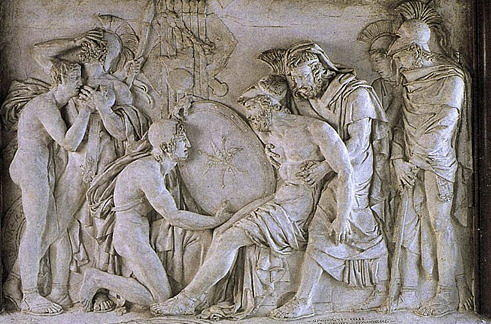
The Death of Epaminondas
418 B.C. – Epaminondas, Greek warrior and general, born (d: 362 B.C.). Considered to have been one of the great military geniuses of the ancient world, he is included here, on Christmas Day, not because of his victories in battle, but because he was revered for his moral character. He was revered, too, since he had risen from an impoverished family because of his goodness, strength and character.
Epaminondas was well educated; his musical teachers were among the best in their disciplines, as was his dance instructor. Most notably, his philosophy instructor Lysis of Tarentum (who had come to live with Polymnis in his exile) was one of the last major Pythagorean philosophers. Epaminondas was devoted to Lysis and was noted for his excellence in philosophical studies.
Not merely an academic, Epaminondas was noted for his physical prowess, and in his youth he devoted much time to strengthening and preparing himself for combat. In 385 B.C., in a skirmish near the city of Mantinea, Epaminondas, at great risk to his own life, saved the life of his future partner Pelopidas, an act thought to have cemented the life-long friendship between the two.
He was, like most Greek warriors, homosexual - but with a difference. He never married and did not produce an heir. His delight in boys was complete in itself for him. His two favorite boys, Asopichus and Leuctra, both fell in battle, as did Epaminondas. Both, by his order, are buried in his tomb.

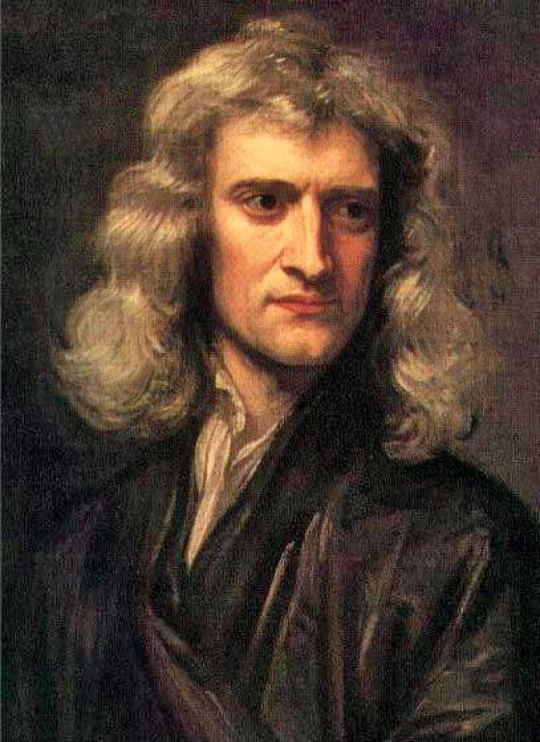
1642 – Sir Isaac Newton (d.1726/27) was an English mathematician, astronomer, theologian and physicist (described in his own day as a "natural philosopher") who is widely recognised as one of the most influential scientists of all time and a key figure in the scientific revolution. His book Philosophiæ Naturalis Principia Mathematica ("Mathematical Principles of Natural Philosophy"), first published in 1687, laid the foundations of classical mechanics. Newton also made pathbreaking contributions to optics, and he shares credit with Gottfried Wilhelm Leibniz for developing the infinitesimal calculus.
Isaac Newton was born (according to the Julian calendar, in use in England at the time) on Christmas Day, 25 December 1642 (NS 4 January 1643) "an hour or two after midnight", at Woolsthorpe Manor in Woolsthorpe-by-Colsterworth, a hamlet in the county of Lincolnshire.
From the age of about twelve until he was seventeen, Newton was educated at The King's School, Grantham, which taught Latin and Greek and probably imparted a significant foundation of mathematics. He was removed from school, and by October 1659, he was to be found at Woolsthorpe-by-Colsterworth, where his mother, widowed for a second time, attempted to make a farmer of him. Newton hated farming. Henry Stokes, master at the King's School, persuaded his mother to send him back to school so that he might complete his education. Motivated partly by a desire for revenge against a schoolyard bully, he became the top-ranked student, distinguishing himself mainly by building sundials and models of windmills.
Newton's Principia formulated the laws of motion and universal gravitation that dominated scientists' view of the physical universe for the next three centuries. By deriving Kepler's laws of planetary motion from his mathematical description of gravity, and using the same principles to account for the trajectories of comets, the tides, the precession of the equinoxes, and other phenomena, Newton removed the last doubts about the validity of the heliocentric model of the Solar System and demonstrated that the motion of objects on Earth and of celestial bodies could be accounted for by the same principles. Newton's theoretical prediction that the Earth is shaped as an oblate spheroid was later vindicated by the geodetic measurements of others, thus convincing most Continental European scientists of the superiority of Newtonian mechanics over the earlier system of Descartes.
Newton also built the first practical reflecting telescope and developed a sophisticated theory of colour based on the observation that a prism decomposes white light into the colours of the visible spectrum. Newton's work on light was collected in his highly influential book Opticks, first published in 1704. He also formulated an empirical law of cooling, made the first theoretical calculation of the speed of sound, and introduced the notion of a Newtonian fluid.
Newton was a fellow of Trinity College and the second Lucasian Professor of Mathematics at the University of Cambridge. He was a devout but unorthodox Christian, who privately rejected the doctrine of the Trinity and who, unusually for a member of the Cambridge faculty of the day, refused to take holy orders in the Church of England.
Beyond his work on the mathematical sciences, Newton dedicated much of his time to the study of alchemy and biblical chronology, but most of his work in those areas remained unpublished until long after his death. Politically and personally tied to the Whig party, Newton served two brief terms as Member of Parliament for the University of Cambridge, in 1689–90 and 1701–02. He was knighted by Queen Anne in 1705 and he spent the last three decades of his life in London, serving as Warden (1696–1700) and Master (1700–1727) of the Royal Mint, as well as president of the Royal Society (1703–1727).Although it was claimed that he was once engaged, Newton never married. The French writer and philosopher Voltaire, who was in London at the time of Newton's funeral, said that he
"was never sensible to any passion, was not subject to the common frailties of mankind, nor had any commerce with women—a circumstance which was assured me by the physician and surgeon who attended him in his last moments".
The widespread belief that he died a virgin has been commented on by writers such as mathematician Charles Hutton, economist John Maynard Keynes, and physicist Carl Sagan.
Newton did have a close friendship with the Swiss mathematician Nicolas Fatio de Duillier, whom he met in London around 1689. Their intense relationship came to an abrupt and unexplained end in 1693, and at the same time Newton suffered a nervous breakdown. Some of their correspondence has survived.
In September of that year, Newton had a breakdown which included sending wild accusatory letters to his friends Samuel Pepys and John Locke. His note to the latter included the charge that Locke "endeavoured to embroil me with woemen". Items like these have led some historians to speculate that Newton was homosexual.


"Artist and Model" - John Minton
1917 – John Minton (d.1957) was a painter of landscapes, town scenes, and figure subjects in oil and watercolor, as well as an acclaimed illustrator. Minton's homosexuality was an important influence on his work. One of his main themes was the young male figure in emotionally charged settings.
Like many middle class gay men of his generation, Minton was drawn to men who fulfilled a manly ideal, and this attraction manifested itself in much of his work, where he portrayed his handsome working class lovers and other ideals of masculinity such as Guardsmen and matadors.
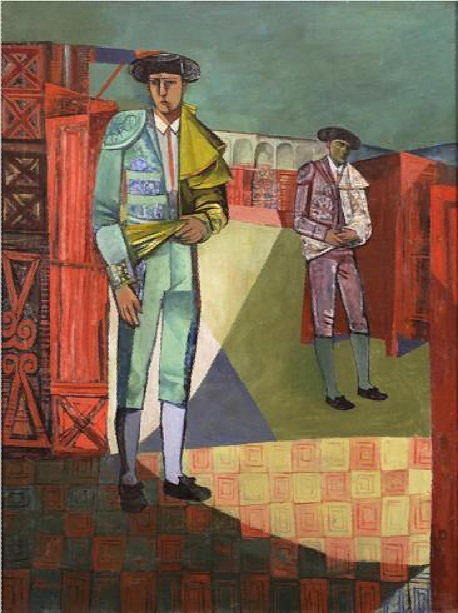
Two Bullfighters
Minton's early work focused on the urban landscape he discovered during nocturnal jaunts around London, where he also discovered an active sexual underground. Visits to Spain in 1949 and Jamaica in 1950 offered Minton a fresh repertoire of subjects and enriched his palette of colors.
Although Minton was dedicated to painting, his reputation developed as a result of his skill as an illustrator for a wide range of books, as well as for magazines such as The Listener and The Radio Times.
Between 1950 and 1952 Minton lived openly with his lover Ricky Stride, a bodybuilding ex-sailor, often his model. Theirs was a volatile relationship and ended as a result of almost constant fighting, which often resulted in violence on Stride's part.
On January 12, 1950, The Listener published a letter Minton wrote in response to a review of a new biography of Oscar Wilde which discussed Wilde's sexuality and relationship with Lord Alfred Douglas in a denigrating fashion. Outraged, Minton pointed out the enormous contribution made to society by homosexuals and highlighted the fact that "the same vicious law which imprisoned Wilde still operates" and pleaded for a "saner and more comprehensive attitude towards the homosexual in society."
Minton's character revealed some great contradictions—his wild gaiety and love of wit and banter disguised and competed with an inner melancholy that verged on depression. Towards the end of his life, Minton began to express an obsession with death, and he was particularly moved by the death of film star and symbol of disaffected youth James Dean.
Minton's output was considerable. Between 1945 and 1956 he had seven solo exhibitions at the Lefevre Gallery, notwithstanding his work as tutor to the painting school of the Royal College of Art in 1949, a post that he held until the year before his death. Minton's appearance in this period is shown in a 1952 portrait by Lucian Freud, as well as in self-portraits. In the 1940s Minton, Freud and fellow artist Adrian Ryan had been in a love triangle.
Minton's last painting, which remained unfinished, was initially based upon a car crash that he had witnessed in Spain; but it also, he told his friend Ruskin Spear, represented "James Dean and all that." As a result the painting was posthumously titled Composition: The Death of James Dean in September 1955.
On January 20, 1957 John Minton committed suicide by taking an overdose of Tuinal.


1950 – Time magazine ran its first article on homosexuality. It said that homosexuals should not work in government jobs because they are a security risk.


1950 – Yehuda Poliker is an Israeli singer, songwriter, musician, and painter. Poliker first became known in the 1980s as the lead vocalist for the band Benzene. In 1985, after the band was dismantled, he began a varied solo career that included motifs from rock, pop and traditional Greek music. He is openly gay.
Yehuda Poliker (birth name: Leonidas Polikaris) was born in Kiryat Haim, a suburb of Haifa, Israel. His parents were Greek Jews and Holocaust survivors who were deported to Auschwitz from Thessaloniki.
In 1981, Poliker began his career-long collaboration with writer and producer Yaakov Gilad. Poliker's band, Benzene, released two albums: 24 Sha'ot (24 Hours) and Mishmeret Layla (Night Watch), which included hit singles such as "Hofshi Ze Legamrei Levad" ("Free Is Totally Alone"), "Geshem" ("Rain") and "Yom Shishi" (Friday). After Benzene broke up, Poliker began a solo career. In 1985, he released his first solo album, Einaim Shely (These Eyes of Mine). All of the tracks on the album were well-known Greek songs literally translated into Hebrew. In 1986, Poliker released his second solo album, Kholem Behakitz (Daydreamer). His third album, Efer VeAvak (Dust and Ashes), released in 1988, dealt mostly with the children of Holocaust survivors. It sold more than 70,000 copies, and in 2005, was rated by Ynet as number one of the top 100 best albums ever recorded in Israel.
Poliker's father, Jacko, told the story of his escape from Auschwitz in the 1988 film Because of That War (Hebrew: B'Glal Hamilhamah Hahi), which featured music by his son. The film included interviews with Yehuda Poliker and Yaakov Gilad, whose parents, Polish Jews, also survived Auschwitz.


1978 – Dylan Vox is an American actor and producer who has worked in television, film and theatre.
Vox was born in Marietta, Georgia, and was adopted one month after birth by Donna Blount. At an early age, he began riding horses and showed Western Pleasure placing in both regional and national competitions. After high school graduation, Vox received bachelor's degrees in Political Science and Journalism from the Georgia Southern University before moving to Denver, Colorado and training with Olympic Ice Dancer Carol Fox where he had some success on the national level with his partner Erin Bales. Vox retired from skating, and attended and graduated from law school.
Vox starred in the Los Angeles premiere of Debbie Does Dallas: The Musical and the world premiere of the hip-hopera "City Kid" earning a LA Stage Alliance Ovation Award nomination and a NAACP theatre award nomination.. He also was an original cast member of Hunky Dory, an original musical interpretation of the 1971 David Bowie album.
Vox appeared as himself on the reality television series Fight for Fame, Open Call, and the Spike detective series Murder. Vox has appeared in the here! cable station's gothic horror series Dante's Cove as Colin and as a series regular in here!'s vampire series The Lair also playing a character named Colin (although they are different characters).

Under the name Brad Benton, Vox performed in many hard and soft gay pornographic films, including Big Timber, Blades, BuckleRoos, Desperate Husbands, Devil Inside, and Longhorns. and was nominated for over 12 GayVN Awards and 15 Grabby Awards, winning Best Supporting Actor at the GayVN Awards in 2004 and 2005 and nine Grabby awards over all.
Vox has written for a number of LGBT-themed websites and writes a blog entitled "21st - Century Vox." He currently serves as the Sports Editor and as a featured columnist for GayWired.com.


1982 – Two married US Army men are found, fully clothed, in bed together and are accused of sex. They say they only fell on the bed while drunk, but accept honorable discharges rather than fight the charges and possibly receive dishonorable discharges.


25 notes
·
View notes
Text
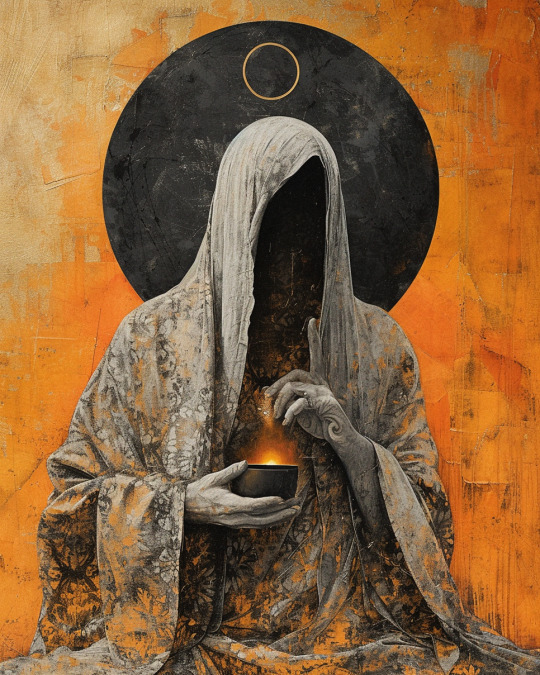
Solar Diety
A solar deity (also sun god(dess)) is a deity who represents the sun, or an aspect of it, usually by its perceived power and strength. Solar deities and sun worship can be found throughout most of recorded history in various forms. Hence, many beliefs have formed around this worship, such as the "missing sun" found in many cultures.
Solar deities throughout cultures
In different religions solarised supreme deities carry different names and are associated with different aspects of the cultural universe of the society, but for the most part its raw image remains identical.
The Neolithic concept of a solar barge, the sun as traversing the sky in a boat, is found in the later myths of ancient Egypt, with Ra and Horus. Earlier Egyptian myths imply that the sun is within the lioness, Sekhmet, at night and can be seen reflected in her eyes or that it is within the cow, Hathor during the night, being reborn each morning as her son (bull). Proto-Indo-European religion has a solar chariot, the sun as traversing the sky in a chariot.
During the Roman Empire, a festival of the birth of the Unconquered Sun (or Dies Natalis Solis Invicti) was celebrated on the winter solstice — the "rebirth" of the sun. In Germanic mythology this is Sol, in Vedic Surya, and in Greek Helios (occasionally referred to as Titan) and (sometimes) as Apollo. Mesopotamian Shamash plays an important role during the Bronze Age, and "my Sun" is eventually used as an address to royalty. Similarly, South American cultures have emphatic Sun worship, see Inti.
During the later periods of Roman history, sun worship gained in importance and ultimately led to what has been called a “solar monotheism.” Nearly all the gods of the period were possessed of solar qualities, and both Christ and Mithra acquired the traits of solar deities. The feast of Sol Invictus (Unconquered Sun) on December 25 was celebrated with great joy, and eventually this date was taken over by the Christians as Christmas, the birthday of Christ.[1]
Hinduism
The Ādityas are one of the principal deities of the Vedic classical Hinduism belonging to Solar class. In the Vedas, numerous hymns are dedicated to Mitra, Varuna and Savitr.
Even the Gayatri mantra, which is regarded as one of the most sacred of the Vedic hymns is dedicated to Savitr, one of the principal Ādityas. The Adityas are a group of solar deities, from the Brahmana period numbering twelve. The ritual of sandhyavandanam, performed by Hindus, is an elaborate set of hand gestures and body movements, designed to greet and revere the sun.
The sun god in Hinduism is an ancient and revered deity. In later Hindu usage, all the Vedic Ādityas lost identity and metamorphosed into one composite deity, Surya, the sun. The attributes of all other Ādityas merged into that of Surya and the names of all other Ādityas became synonymous with or epithets of Surya.
The Ramayana has Lord Rama as a descendant of the Surya, thus belonging to the Surya Vansh or the clan of the Sun. The Mahabharata describes one of its warrior heroes Karna as being the son of the Pandava mother Kunti and Surya.
The sun god is said to married to the goddess Ranaadeh, also known as Sanjnya. She is depicted in dual form, being both sunlight and shadow, personified. The goddess is revered in Gujarat and Rajasthan.
The charioteer of Surya is Aruna, who is also personified as the redness that accompanies the sunlight in dawn and dusk. The Sun God is driven by a seven-horsed Chariot depicting the seven days of the week.
In India, at Konark, in the state of Orissa, a temple is dedicated to Surya. The Konark temple has also been declared a UNESCO world heritage site. Surya is the most prominent of the navagrahas or nine celestial objects of the Hindus. Navagrahas can be found in almost all Hindu temples. There are further temples dedicated to Surya, one in Arasavilli, Srikakulam District in AndhraPradesh, one in Gujarat and another in Rajasthan. The temple at Arasavilli was constructed in such a way that on the day of Radhasaptami, the sun's rays directly fall on the feet of the Sri Suryanarayana Swami, the deity at the temple.
Chhath (Hindi: छठ, also called Dala Chhath) is an ancient Hindu festival dedicated to Surya, the chief solar deity, unique to Bihar, Jharkhand and the Terai. This major festival is also celebrated in the northeast region of India, Madhya Pradesh, Uttar Pradesh, and parts of Chhattisgarh.Hymns praying to the sun can be found in the Vedas, the oldest sacred texts of Hinduism. Practiced in different parts of India, the worship of the sun has been described in the Rigveda.
Ancient Egypt
Sun worship was exceptionally prevalent in ancient Egyptian religion. The earliest deities associated with the sun are Wadjet, Sekhmet, Hathor, Nut, Bastet, Bat, and Menhit. First Hathor, and then Isis, give birth to and nurse Horus and Ra. Hathor the horned-cow is one of the twelve daughters of Ra, gifted with joy and is a wet-nurse to Horus.
The sun's movement across the sky represents a struggle between the Pharaoh's soul and an avatar of Osiris. Ra travels across the sky in his solar-boat; at dawn he drives away the demon apep of darkness. The "solarisation" of several local gods (Hnum-Re, Min-Re, Amon-Re) reaches its peak in the period of the fifth dynasty.
In the eighteenth dynasty, Akhenaten changed the polytheistic religion of Egypt to a monotheistic one, Atenism of the solar-disk and is the first recorded state monotheism. All other deities were replaced by the Aten, including, Amun-Ra, the reigning sun god of Akhenaten's own region. Unlike other deities, the Aten did not have multiple forms. His only image was a disk—a symbol of the sun.
Soon after Akhenaten's death, worship of the traditional deities was reestablished by the religious leaders (Ay the High-Priest of Amen-Ra, mentor of Tutankhaten/Tutankhamen) who had adopted the Aten during the reign of Akhenaten.
Chinese mythology
In Chinese mythological cosmology, there were originally ten suns in the sky, who were all brothers. They were supposed to emerge one at a time as commanded by the Jade Emperor. They were all very young and loved to fool around. Once they decided to all go into the sky to play, all at once. This made the world too hot and nothing grew. A hero named Hou Yi shot down nine of them with a bow and arrow to save the people of the earth. He is still honored to this day. In another myth, the solar eclipse was caused by the magical dog of heaven biting off a piece of the sun. The referenced event is said to have occurred around 2,160BCE. There was a tradition in China to make lots of loud celebratory sounds during a solar eclipse to scare the sacred "dog" away. The Deity of the Sun in Chinese mythology is Ri Gong Tai Yang Xing Jun (Tai Yang Gong / Grandfather Sun) or Star Lord of the Solar Palace, Lord of the Sun. In some mythologies, Tai Yang Xing Jun is believed to be Hou Yi. Tai Yang Xing Jun is usually decipted with the Star Lord of the Lunar Palace, Lord of the Moon, Yue Gong Tai Yin Xing Jun (Tai Yin Niang Niang / Lady Tai Yin).
Buddhism
In Buddhist cosmology, the bodhisattva of the sun is known as Ri Gong Ri Guang Pu Sa (The Bright Solar Boddhisattva of the Solar Palace) / Ri Gong Ri Guang Tian Zi (The Bright Solar Prince of the Solar Palace) / Ri Gong Ri Guang Zun Tian Pu Sa (The Greatly Revered Bright Solar Prince of the Solar Palace / one of the 20 or 24 guardian devas). In Sanskrit, He is known as Suryaprabha. He is usually decipted with Yue Gong Yue Guang Pu Sa (The Bright Lunar Boddhisattva of the Lunar Palace) / Yue Gong Yue Guang Tian Zi ( The Bright Lunar Prince of the Lunar Palace) / Yue Gong Yue Guang Zun Tian Pu Sa (The Greatly Revered Bright Lunar Prince of the Lunar Palace / one of the 20 or 24 guardian devas) or known as Candraprabha in Sanskrit. With Yao Shi Fo / Bhaisajyaguru Buddha (Medicine Buddha), these two boddhisattvas create the Dong Fang San Sheng or the Three Holy Sages of the East.
Africa
The Munshi tribe considers the sun to be the son of the supreme being Awondo and the moon is Awondo's daughter. The Barotse tribe believes that the Sun is inhabited by the sky god Nyambi and the Moon is his wife. Even where the sun god is equated with the supreme being, in some African mythologies he or she does not have any special functions or privileges as compared to other deities.
Aztec mythology
In Aztec mythology, Tonatiuh (Nahuatl:Ollin Tonatiuh "Movement of the Sun") was the sun god. The Aztec people considered him the leader of Tollan, heaven. He was also known as the fifth sun, because the Aztecs believed that he was the sun that took over when the fourth sun was expelled from the sky. According to their cosmology, each sun was a god with its own cosmic era. According to the Aztecs, they were still in Tonatiuh's era. According to the Aztec creation myth, the god demanded human sacrifice as tribute and without it would refuse to move through the sky. It is said that 20,000 people were sacrificed each year to Tonatiuh and other gods, though this number is thought to be inflated either by the Aztecs, who wanted to inspire fear in their enemies, or the Spaniards, who wanted to vilify the Aztecs. The Aztecs were fascinated by the sun and carefully observed it, and had a solar calendar second only in accuracy to the Mayan's. Many of today's remaining Aztec monuments have structures aligned with the sun.
In the Aztec calendar, Tonatiuh is the lord of the thirteen days from 1 Death to 13 Flint. The preceding thirteen days are ruled over by Chalchiuhtlicue, and the following thirteen by Tlaloc.
Indonesian mythology
The same swapping process is seen in Indonesia. The solar gods have a stronger presence in Indonesia's religious life and myth. In some cases the sun is revered as a "father" or "founder" of the tribe. This may apply for the whole tribe or only for the royal and ruling families. This practise is more common in Australia and on the island of Timor, where the tribal leaders are seen as direct heirs to the sun god.
Some of the initiation rites include the second reincarnation of the rite's subject as a "son of the sun", through a symbolic death and a rebirth in the form of a sun. These rituals hint that the Sun may have an important role in the sphere of funerary beliefs. Watching the un's path has given birth to the idea in some societies that the deity of the Sun descends in to the underworld without dying and is capable of returning afterward. This is the reason for the Sun being associated with functions such as guide of the deceased tribe members to the underworld, as well as with revival of perished. The sun is a mediator between the planes of the living and the dead.
Theosophy The primary local deity in Theosophy is the Solar Logos, i.e., the consciousness of the sun.
62 notes
·
View notes
Photo
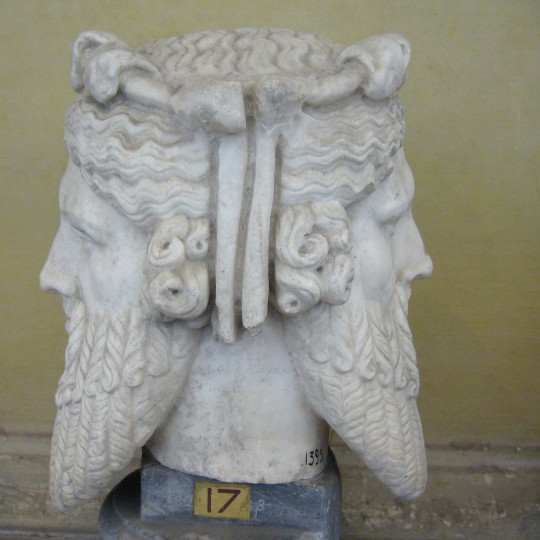
Gods & Goddesses of Rebirth & Renewal Around the World
Deities representing the concepts of rebirth and renewal have been a vital aspect of the human condition for thousands of years. Early animistic belief systems venerated the sun, which later became associated with powerful deities, such as Ra of ancient Egypt, as other gods and goddesses were associated with different natural phenomena or life experiences.
Among these, and including those representing the life-giving energies of the sun, are the gods and goddesses specifically associated with rebirth, transformation, and renewal. Some of these, such as Sol Invictus and Saturn of ancient Rome, were celebrated in December through festivals, which influenced the development of Yule (Yuletide) and Christmas traditions, while others were honored through festivals at different times of the year, as in the case of the Hindu goddess Saraswati (also given as Sarasvati) and her Vasant (Basant) Panchami festival in January or February or the Great Dionysia, honoring the ancient Greek god Dionysus, held in March.
The purpose of these deities and their respective festivals was to give hope to the people that, through faith, they could experience transformation and rebirth, meaning and purpose in their daily lives, and – in many cases – freedom from the fear of death in the promise of eternal life beyond the grave.
The following image gallery presents a sample of these deities from around the world, some more famous than others, but all representing the belief in transformation and rebirth through faith in a higher power.
Continue reading...
25 notes
·
View notes
Text

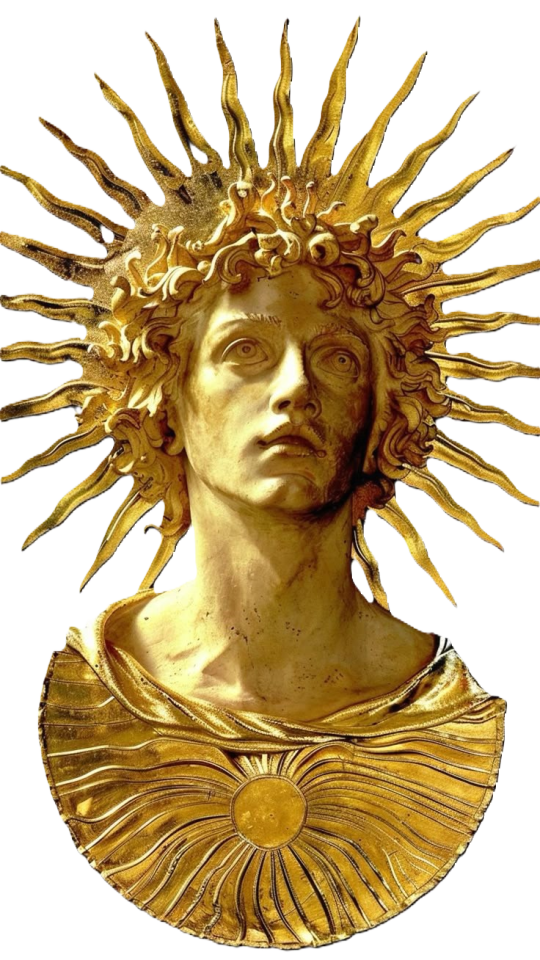
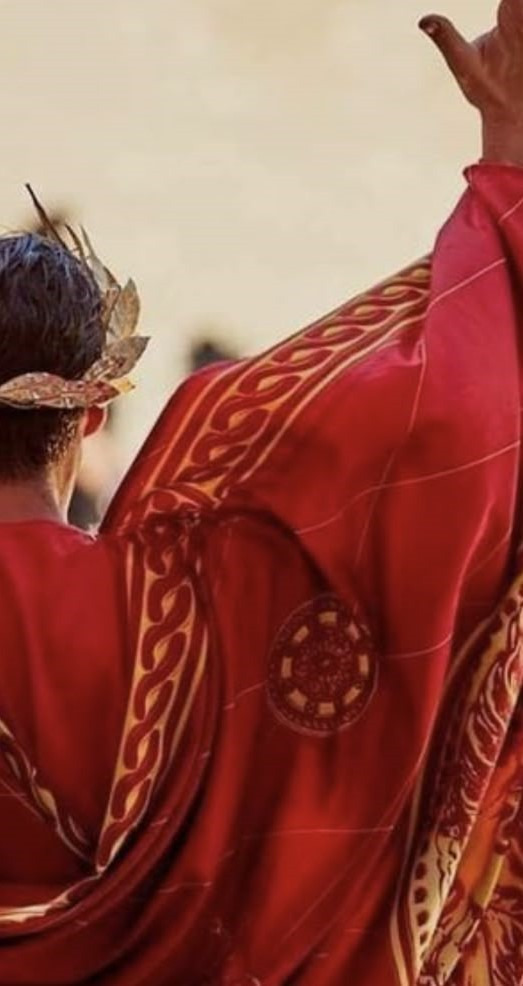
Mithras, God of the Morning, our trumpets waken the Wall! Thou descending immortal, immortal to rise again! Now when the watch is ended, now when the wine is drawn, Look on Thy children in darkness. Oh take our sacrifice! Many roads Thou hast fashioned: all of them lead to the Light, Mithras, also a soldier, keep us pure till the dawn!
— A Song to Mithras, Hymn of the XXX Legion: circa A.D. 350.

#Mithras#mithras deity#mithras deus#Mithra#mithra deity#mithraic mysteries#mithraism#roman polytheism#roman mythology#Persian polytheism#zoroastrianism#aesthetic#moodboard#hymn#sol invictus#iranian polytheism#persian mythology#Iranian mythology#ancient rome#roman art#roman army#roman antiquity#roman pantheon
16 notes
·
View notes
Text
The Sun
If the Sun is your dominant planet, then this flame is yours to carry.

Signs You Are Blessed by the Sun
You are generous without thinking
Your hands are warm, even when others are cold
You are egoistic, but magnetic
You are hotheaded, but sincere
You shine even when silent
Others are drawn to you instinctively
You thrive in daylight, summer, and celebration
You burn through lies and speak from the chest
Divine Gifts
Victory, Triumph, Glory
Happiness, Joy
Fame, Music
Competition, Fandom
Beauty, Sexual Energy
Charisma, Will, Creative Fire
Dominions of the Sun
The Sun governs not just the sky — but the structure of spirit and power.
The Sun in your chart marks your true essence, the spark at your core.
Leo, its royal sign, governs confidence, performance, and dignity.
The Fifth House holds creativity, pleasure, children, fame, and passion.
The Solstices are its sacred gates — the Summer Solstice, when the Sun is at its most triumphant, the Winter Solstice, when its spark hides, yet begins its return.
Gold is its metal: radiant, incorruptible. To wear pure gold is to wear sunlight. It awakens what sleeps within — ancestral gifts, silent powers, forgotten talents. If you seek to awaken a gift (like healing), wear gold as you work: the Sun will know, and answer.
Correspondences
Day: Sunday
Color: Gold, Amber, Bright Yellow
Metal: Gold
Crystals: Citrine, Sunstone, Amber, Carnelian
Plants: Bay Laurel, Rosemary, Calendula, St. John's Wort, Sunflower
Animals: Lion, Rooster, Dog
Incense: Frankincense, Copal, Cinnamon
Tarot: The Chariot (VII), The Sun (XIX)
Direction: South
Time: Noon
Season: Summer
Energy: Active, Projective, Radiant
Solar Deities
Across time and land, many faces have worn the crown of the Sun:
Apollo (Greece): god of light, prophecy, healing, and music. He drove the chariot of the sun and slew the Python — a myth echoed centuries later in the figure of Saint Michael, who slays the devil.
Sol Invictus (Rome): the Unconquered Sun — a force of triumph and eternity.
Ra (Egypt): the one who sails the sky by day and braves the underworld by night, renewing light.
Amaterasu (Japan): her radiance sustains the world — when she hides, all withers.
Lugh (Celtic): radiant warrior-poet of skill and light, associated with harvest and summer’s peak.
Áine (Irish): goddess of summer, sovereignty, and desire — a solar queen in soft disguise.
Belenus (Gaulish): the Bright One, god of light, healing, and fiery protection.
Sol (Norse): a charioteer goddess chased by wolves, her radiance chased yet unwavering.
Baldr (Norse): luminous god of purity and peace, with solar sorrow at his heart.
Huitzilopochtli (Aztec): fierce sun-warrior god, whose fire must be fed to rise again.
The solar flame wears many faces, but always brings life, glory, and judgment.
#witchblr#witchcraft#witches#magick#baby witch#grimoire#divination#astrology#sun#apollo#paganblr#paganism#pagan witch
6 notes
·
View notes
Note
Hi! Just wanted to clarify after the last ask you had, that Apollo was also a sun god... Not the Sun itself and the one who drives the sun across the sky, that was always Helios in greek mythology! Same with Artemis and Selene (and Hekate who was associated with the Moon too)
Someone in the comments section had explained very well, but in roman times Helios and Apollo (and Selene and Artemis) were fully conflated, they were syncretized and this fully conflation in roman times made that in Renaissance, when artists took inspiration in grecorroman's culture, put Artemis and Apollo as the ones who drives the sun and moon chariots. But that never happenned in greek mythology.
Btw, they had associations with moon and sun, so is not wrong to call them sun and moon deities... What is wrong and inaccurate is to say that Odysseus' crew killed Apollo's cows, that's not true... That cattle was always from Helios, the sun god itself, the sun incarnate. Was Helios' cattle in Odyssey and in Epic too!
Also yes... Artemis and Apollo had many others domains and roles in greek mythology, and they weren't sun and moon deities primarly, is not their main role, but is not wrong to say that they were associated with those too... Could be because their roles are linked to the moon and sun, like hunt, wildness, childbirth and transitions are linked to the Moon, and healing, purification, inspiration and truth (like illumination of the mind) are linked to the Sun... (this is a theory, i don't know specifically how or why they were fully associated, but they were at one point, becoming a sun god and a moon goddess)
Anyway, the history and cult of the gods were differents in each region and period... Greek mythology (religion in those times) is not like "god of this" and "god of that", domains and roles of differents gods merged and deites could share domains. How many "fertility's gods and goddesses" are? Is not weird that more of two deities were linked to the Sun and the Moon. Even Zeus was linked to the sun in later times, i believe (please someone correct me if i'm wrong) that Sol Invictus was seeing as a conflation between Helios and Zeus i some period.
Selene and Helios are the Moon and Sun itself, Helios is the owner of the cattle that Odysseus' crew killed, they never faded, but the olympian twins were associated to them and become in later times, sun and moon deities too.
i just will say thank you for info!
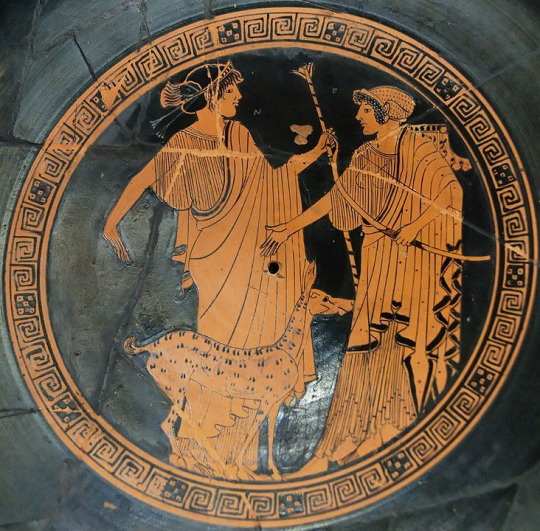
37 notes
·
View notes
Text
Okay this might mean nothing but…get your red string ready cause this is my Doctor Who S14/S1 theory masterpost
*Disclaimer in case of inaccuracies, I started writing this before Dot and Bubble was released and then I got busy and more things happened and now it's release day for The Legend of Ruby Sunday (which won’t be available to watch in my country until this evening) and I didn’t want it to go to waste so I finished it lol okay thanks*
I’ve been thinking a lot about @waywardwes9 ’s theory regarding Ruby Sunday and other character names in this series of Doctor Who. So we’ve had Ruby SUNDAY, MUNDI (Monday) Flynn in episode three, and MARTI (Mardi/Martes/Tuesday/etc) Bridges in episode four, with dialogue bringing attention to the uniqueness/significance of each of their names. So when the casting list was released for episode five, ‘Dot and Bubble’, I couldn’t help but notice…Cooper Mercy, a slightly adjusted form of the words Mercury, or Mercredi (fr)/Miércoles (sp)/Mercoledì (it)/dydd Mercher (welsh)/etc. all of which means Wednesday!! So up until episode six, ‘Rogue’, this theory appeared to be holding up. It then became difficult to speculate further as we had little to no character backgrounds for these individuals and the cast lists for the remaining episodes are still incomplete but twice is a coincidence, four times is a pattern.

Now we know that in the ancient Greco-Roman tradition, the days of the week were named after the sun, moon and planets which were in turn named after certain gods:
Monday - Moon - Selene/Luna
Tuesday - Mars - Ares/Mars
Wednesday - Mercury - Hermes/Mercurius
Thursday - Jupiter - Zeus/Jove
Friday - Venus - Aphrodite/Venus
Saturday - Saturn - Cronus/Saturnus
Sunday - Sun - Helios/Sol
Because of her surname, Ruby Sunday would be aligned with the Roman God ‘Sol Invictus’, who was considered the most supreme or important god for several decades of the mid to late Roman empire. So I decided to do a little research into this deity and found out that his feast day and the main festival dedicated to him, ‘Dies Natalis Solis Invicti’, occurred every year on December 25th… The day on which at the stroke of midnight, baby Ruby was discovered in a snowy churchyard, after being abandoned by her mysterious mother. This could just be a coincidence but it’s interesting nonetheless as it adds to the themes and theories regarding the “Pantheon of Discord” which includes godlike figures such as The Toymaker and Maestro. Could this suggest that Ruby is secretly a member of the Pantheon of gods? Or maybe she was created to be a pawn, a messiah-like figure, in their masterplan? Or maybe she’s a part of an antithetical pantheon of ‘good’ gods?
So returning to the characters named after weekdays, we may have expected a character with some variation of Thursday/Jeudi/Giovedì/dydd Iau/etc. as their name to appear in Rogue but unfortunately, there appeared to be nothing at all that would correlate to this theory… until people began to notice that the ring which Rogue uses to propose to The Doctor is emblazoned with The Caduceus, the staff of Hermes… also known as Mercurius or Mercury.

It seems that our story has become stuck on Wednesday instead of continuing with the remaining weekdays, but why? Why could Wednesday or Mercury be significant? Well gang, guess what the god Mercury is known as…

THIS IS HOW THE TRICKSTER TRUTHERS CAN STILL WIN !! Additionally, Rogue’s name originates from the DnD archetype, ‘Rogue’, who is regarded as ‘the trickster’. Very Inch Arresting. but we’ll return to the Trickster as ‘The One Who Waits’ theories a little later on.
The theory regarding The Caduceus can also play into the theory about Rogue possibly being an incarnation of The Master, or signalling the return of The Master. The Caduceus symbol, which can represent travel, thievery and mischief (which aligns with characteristics of The Rogue, The Trickster and The Master) is commonly mistaken or used in place of The Rod of Asclepius, which is used by healthcare organisations as it represents healing, care and the duties of doctors (which obviously aligns with The Doctor).

These antithetical yet similar symbols could easily represent the Doctor and The Master and their shared past and turbulent relationship, or alternatively could represent the theme that things that appear too good to be true usually are, but who knows.
Now if you’ve made it this far, stay with me for this part because we’re about to get even more delulu, but I promise we’ll come back around into more plausible theory territory very soon.
So with all this attention being drawn to character names, I decided to do some further research into the names of the characters named after days of the week and found something interesting. In the case of Mundi Flynn, we can presume Mundi is intended to mean Monday but Flynn actually means…Red or ruddy/reddish, which would make her name Monday Red… or Red Monday… just like Ruby Sunday. This got me extremely excited…until…I couldn’t find any connections to the colour red within Marti’s surname ‘Bridges’. However… Marti is named after Mars, which is known as… The Red Planet! Which would still make her first name Red Tuesday, or even Ruby Tuesday just like the famous song by the Rolling Stones. Now That is a stretch but we persist nonetheless by going even deeper into delusional valley with Dot and Bubble’s character: Cooper Mercy, Cooper…an uncommon name that is very close to the word ‘Copper’.. another shade of red, making her Wednesday Red/Ruby Wednesday. Also worthy to note that the character Cooper had red hair, which was a purposeful choice as it is not the actor’s natural hair colour. Okay, last one… while there doesn’t appear to be any weekday names mentioned in Rogue, (as we seem to be stuck on Wednesday) I couldn’t help but notice that ‘Rogue’ is an anagram of Rouge… the french word for red. Listen, either this all actually connects or RTD has quite literally been sprinkling RED herrings throughout the narrative. So what could this mean? Personally, this kind of repetitive naming convention reminds me of a dream-like logic or storytelling convention centred around Ruby, which could play into everyone’s TV show/fairytale/dream theories (which are too expansive to get into and I don’t have much to add).

*I’ve heard that the Identity of Susan Twist has been revealed in today’s episode but thankfully I haven’t seen any spoilers yet so just ignore this if it’s completely off the wall lol*
However, this could also link to the idea of Susan Twist as a show director or writer, making cameos throughout her own work. In this light, she could be considered The Storyteller… TS… but if you physically twist the initials around…ST… Susan Twist.
Then, there is of course the theory that Susan Twist is a physical manifestation of the Tardis. Particularly because in The Legend of Ruby Sunday she has been listed as Susan Triad, S.Triad, an anagram of Tardis. Could it be that the tardis is broken down or malfunctioning and is creating these scenarios to keep itself, the Doctor and Ruby entertained? I guess I’ll find out tonight hehe.
Okay getting back to The Trickster theory. By now most people have probably seen other posts that show that Ruby’s musical theme is almost identical to The Trickster’s theme from SJA, that the Doctor invoking a superstition at the edge of the universe could have brought back the Trickster, that RTD could be using Ruby as a replacement for Sky from SJA, the baby that Sarah Jane discovered abandoned on her doorstep and adopted, who was originally supposed to be revealed as a child of the Trickster and a trap for Sarah Jane, and as well ofc that the hooded figure that drops baby Ruby off obviously resembles The Trickster.

But another thing I can’t stop thinking about is the theme of the fragility of memory and existence that has been popping up throughout this series, particularly in the first few episodes, and how this correlates to the powers of The Trickster. In Space Babies, we see how the doctor’s memories of the night of Ruby’s birth are manipulated in real time to show him something totally different. In 73 Yards, we see how the Doctor is zapped out of existence, and then brought back through a future-past paradox. In several episodes we see the blurring of reality, the past and fiction with events such as the snow from Ruby Road appearing in places where present day Ruby is. We see on two occasions how history is changed by the simplest of actions such as stepping on a butterfly or a fairy circle. And of course in 73 Yards we hear Kate’s cryptic “This timeline is suspended along your event” line. All of these elements appear to correspond with the Trickster’s powers of time and memory manipulation as demonstrated in SJA, to the point that I’m actually gonna be disappointed if all this build up doesn’t result in an appearance from everyone’s fav SJA villain lol.
Another thing to consider is The Doctor’s continuous references to the sea constantly getting closer to the land such as the “Everywhere is a beach eventually.” line from episode three and the “The war between the land and the sea” comment in episode four, the latter of which could of course just be a nod to the forthcoming dw spin-off series of the same name… or… could in fact be a reference to ‘the one who waits’. The last time the Trickster was defeated he was locked up in a box and thrown into the ocean, where he could be waiting patiently to return to the shore, to claim what he wants. Could this also be linked to Mrs FLOOD, whose water-related name may suggest that she is the one who waits for the oncoming flood. Who knows ! I’m just throwing things at the red string board and hoping something sticks.
Okay that’s all for my crazy wacky wild bananas bonkers theories today. Can’t wait to see how many of these are disproven in approximately one hour lmaoooo. If you made it this far, I commend ur patience <3
#doctor who#ruby sunday#the trickster#susan twist#the legend of ruby sunday#dw theory#doctor who theory#the one who waits
27 notes
·
View notes
Text

Bronze follis (20 mm; 3.73 g) of the Roman emperor Constantine I "the Great" (r. 306-337 CE), minted at Aquileia, 316-17. On the obverse is the laureate bust of Constantine. On the reverse is the sun god Sol, shown with his usual radiant crown and holding a globe.
At the time this coin was struck, Constantine was master of the western half of the Empire, having defeated his rival Maxentius at the Battle of the Milvian Bridge (312). The following year, he and the Eastern emperor Licinius had jointly issued the Edict of Milan, which provided for religious toleration and ended official persecution of Christianity, now a "permitted religion" (religio licita), in their domains. This coin, however, shows no obvious signs of the changing religious landscape. Sol, in his manifestation as the Unconquered Sun (Sol Invictus), was widely popular in cult and had been the patron deity of the earlier emperor Aurelian, who styled himself "Restorer of the World" (Restitutor Orbis). It is possible that Constantine, whatever his personal religious leanings after the Milvian Bridge, thought it politically savvy to retain traditional solar imagery on his coinage so as not to alienate his pagan subjects. Another possibility, not incompatible with the first, is that Constantine identified the Christian God with Sol, both being understood as all-seeing, all-powerful deities who favored his cause and furnished victory in battle.
Photo credit: Classical Numismatic Group, Inc. http://www.cngcoins.com | Creative Commons Attribution-Share Alike 2.5 Generic
#classics#tagamemnon#history#ancient history#Ancient Rome#Roman Empire#Roman history#Constantine I#Constantine the Great#art#art history#ancient art#Roman art#Ancient Roman art#Roman Imperial art#late antiquity#late antique art#coins#ancient coins#Roman coins#Ancient Roman coins#numismatics#ancient numismatics#Roman numismatics#follis
33 notes
·
View notes